
Emerging reorganisation proposals
Our Interim Proposal is split into two parts: Part A and Part B (currently reading).
In this part we set out Surrey County Council's emerging proposals for LGR. This includes a high-level appraisal of the options for LGR in Surrey, using a qualitative assessment of the relative advantages and disadvantages of each option against the government's criteria for LGR and principles for reorganisation. We also set out an early financial appraisal of the costs and benefits for each option.
Based on our assessment, we believe that reorganising the current 12 councils into two new unitary authorities is the best direction for Surrey to unlock devolution, realise improved local government services, create more financially sustainable local government and to lay the foundations for future public service reform. A shortlist of potential geographical configurations being considered for these unitaries has been included.
This part of the interim plan also sets out initial thinking for implementation, including indicative costs, as well as stakeholder engagement carried out so far and further planned engagement.

High-level options appraisal
We have reviewed potential options for future unitary local government structures in Surrey. In selecting options for review we considered the likelihood of them meeting the government's criteria for LGR, as well as our own principles of the need for them to be coterminous – contained within the existing Surrey county boundary and potential to align with the footprints of other public sector partners – and contiguous – making sure existing district and borough boundaries were not split. This is also in line with government's request that existing district and borough areas are viewed as the building blocks for proposals.
A further key principle is that no new council should be set up to fail. This is particularly important if multiple unitary councils are the outcome of the LGR process as the new organisations should have relative equity and parity of financial resilience and sustainability, service demand levels and economic prospects from day one.
We have combined qualitative and quantitative data sources to support our appraisal against the criteria set by Ministry of Housing, Communities and Local Government (MHCLG):
- A proposal should seek to achieve for the whole of the area concerned the establishment of a single tier of local government.
- Unitary local government must be the right size to achieve efficiencies, improve capacity and withstand financial shocks. As a guiding principle, the government has said that new councils should aim for a population of 500,000 people or more. They should also deliver financial efficiencies.
- Unitary structures must prioritise the delivery of high-quality public and sustainable public services to citizens.
- Proposals should show how councils in the area have sought to work together in coming to a view that meets local needs and is informed by local views.
- New unitary structures must support devolution arrangements.
- New unitary structures should enable stronger community engagement and deliver genuine opportunity for neighbourhood empowerment.
To complement these, we have also looked at additional criteria which capture the issues that matter to our residents and businesses. These are:
- Impact on service delivery – transitioning to the new arrangements must minimise disruption to service delivery, the potential demand for services new unitary authorities may experience, opportunities to transform services and impacts on partnership working.
- Growth – assessing the economic health and resilience inherited by the new arrangements, extent to which residents benefit from the proceeds of growth, moving to a future that encourages clean, green growth and infrastructure, and enables establishment of a Strategic Authority.
- Democratic representation – ensuring local democratic representation is maintained, and where possible, enhanced under the new structures. The new authorities will reflect local identities recognisable to residents and give regard to alignment with functional economic areas.
- Financial resilience and sustainability – establishing structures that lead to services delivered at lower cost, funding required for re-organisation, including potential for service disaggregation costs in multiple unitary arrangements, potential for generating income and overall financial resilience.
Reviewing the options
In the context of the above, the options we have considered are:
- A single unitary authority, which covers the existing county footprint of Surrey and the population of over 1.2 million people.
- Two unitary authorities, covering populations of between 500,000 and 600,000 people each.
- Three unitary authorities, covering populations of upwards of 370,000 people each.
Overview of our assessment
Below is a summary of our options appraisal, highlighting how each unitary arrangement performs against the government's LGR criteria and our additional criteria. This incorporates the results of the financial assessment, which are described in detail later in this plan. Democratic governance arrangements have not been scored as part of this exercise, but we have proposed councillor numbers for the new unitaries in later sections.
Early on, we ruled out pursuing a single unitary authority option as it will not unlock the benefits of further devolution for Surrey residents. Government criteria mean that a single unitary council and Mayoral Strategic Authority cannot be established on the same geographical footprint. However, it is acknowledged that this arrangement would have supported greater financial efficiencies and minimised disruption to county-wide services from disaggregation.
We have scored the criteria for the remaining options between one and three – one meaning it meets very few or none of the criterion's requirements, two meaning it meets some of the requirements and three meaning alignment to most or all of the criterion. Each of the criteria have then been weighted linked to the desired outcomes from LGR. Weightings range from one, which is considered a relatively less important outcome from LGR, to five which is a crucial outcome to achieve from the process.
We think the extent to which each option meets criteria on whether the new arrangements would unlock devolution and if they meet the government's population criteria are crucial. They underpin the rationale for LGR and the degree to which they are likely to be acceptable to government.
Two unitaries
| Criteria | Highlights | Score |
|---|---|---|
| Unlocks devolution (weighting = 5) |
| 3 |
| Population = 500,000 or more (weighting = 5) |
| 3 |
| Resilience and ability to withstand financial shocks (weighting = 5) |
| 2 |
| Delivers high quality, sustainable public services (weighting = 5) |
| 2 |
| Local identities and community empowerment (weighting = 5) |
| 2 |
| Impact on service delivery (weighting = 4) |
| 2 |
| Growth (weighting = 3) |
| 2 |
| Financial resilience and sustainability (weighting = 5) |
| 2 |
Total raw scores
18
Total weighted scores (scores x weighting - maximum score possible)
111
Conclusion
Preferred option - likely to meet government requirements.
Three unitaries
| Criteria | Highlights | Score |
|---|---|---|
| Unlocks devolution (weighting = 5) |
| 3 |
| Population = 500,000 or more (weighting = 5) |
| 1 |
| Resilience and ability to withstand financial shocks (weighting = 5) |
| 1 |
| Delivers high quality, sustainable public services (weighting = 5) |
| 1 |
| Local identities and community empowerment (weighting = 5) |
| 2 |
| Impact on service delivery (weighting = 4) |
| 1 |
| Growth (weighting = 3) |
| 1 |
| Financial resilience and sustainability (weighting = 5) |
| 1 |
Total raw scores
11
Total weighted scores (scores x weighting - maximum score possible)
52
Conclusion
Unlikely to meet government requirements.
Further detail on the qualitative and financial appraisals for each unitary option are set out below, starting with our preferred option.
Two unitary authorities
This would lead to the creation of two new unitary authorities with either an east/west divide or a north/south divide, both with populations exceeding 500,000. These boundaries would be collectively coterminous with the current county boundaries, using district and borough council areas as building blocks for the geographies of the new authorities.
We set out advantages and disadvantages of two unitary authorities below. Most of these apply irrespective of geographical arrangement.
Advantages:
- Devolution – a new Strategic Authority for Surrey could be established which would be coterminous with the current county boundaries.
- Services would be simplified and improved compared to arrangements under the current 12 councils in Surrey.
- Services that are fragmented could be combined to create scale, such as waste collection and disposal services.
- Partnership working with other public service partners, such as police and health, could be enhanced if delivery footprints are aligned.
- Right scale to build on existing work to strengthen participation and engagement across Surrey's towns and villages
- The new authorities would be able to direct and tailor use of resources to the specific needs of the communities living in each authority's area.
- Greater depth of understanding of economic challenges and opportunities in each unitary area compared to a single unitary.
- There would be enhanced financial sustainability with two unitary authorities compared to three unitary authorities and the current system of 12 councils.
- All geographies under consideration for two unitaries will meet the government's criteria of a population of 500,000 and over. Size offers greater potential for enhanced organisational resilience.
Disadvantages:
- Establishing two new councils would create multiple touchpoints for some services currently accessed by a single front door, adding complexity to the system and potential for inconsistency of outcomes, though this complexity would be less compared to the 12 councils currently operating.
- Disaggregating county-wide services would impact on the cost, consistency and quality of those services, such as creating a need for two Directors of Adult and Children's Social Care and management teams for both areas.
- There is a risk of disparity in service provision due to uneven distribution of staff with the right knowledge, skills and experience.
- Two unitaries may be perceived by residents as more remote from the places they live – we set out mitigations for this in the democracy and governance section.
- Risk a more economically prosperous authority reinvests proceeds of growth, e.g. business rates, within its own area, leaving the less prosperous authority behind.
- Risk of uneven economic asset split, such as employment centres and innovation clusters.
- Given the level of existing debt across Surrey's 12 councils, there is a risk that at least one of the new authorities would need Exceptional Financial Support from inheriting this debt if an alternative solution was not found.
Four potential geographical arrangements for two unitaries are under consideration. Other arrangements were reviewed but were discounted as they did not meet either the government's or our own criteria.
For each two-unitary geography being considered, tables have been included to show how the areas would split across key financial and socio-economic indicators, using a snapshot of the latest available data for each indicator. Further analysis will be done to assess interplay across these indicators and should not be taken as measures of absolute costs or needs.
Option 2.1: East/West
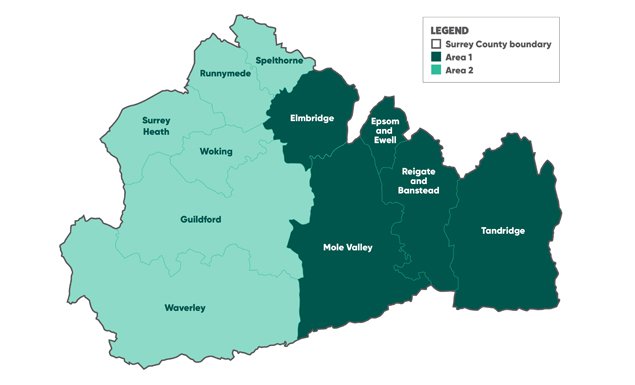
| Area | East | West |
|---|---|---|
| District and Boroughs | Elmbridge, Epsom and Ewell, Mole Valley, Reigate and Banstead, Tandridge | Guildford, Runnymede, Spelthorne, Surrey Heath, Waverley, Woking |
| Population | 545,798 | 657,309 |
| Proposed number of councillors | 72 | 90 |
Key metrics (area split as percentage)
| Area | East | West |
|---|---|---|
| Adult social care users being supported | 9,720 (43%) | 12,986 (57%) |
| Children in need | 2,085 (44%) | 2,687 (56%) |
| Children with Education Health and Care Plans | 7,214 (45%) | 8,792 (55%) |
| Pupils in school | 72,835 (45%) | 88,585 (55%) |
| Eligible for home to school travel assistance | 3,545 (43%) | 4,685 (57%) |
| Road miles | 1,355 (45%) | 1,666 (55%) |
| Anticipated council tax income | £528.23 million (47%) | £579.66 million (53%) |
| Gross value added | £22.8 billion (44%) | £28.5 billion (56%) |
Option 2.2: East/West
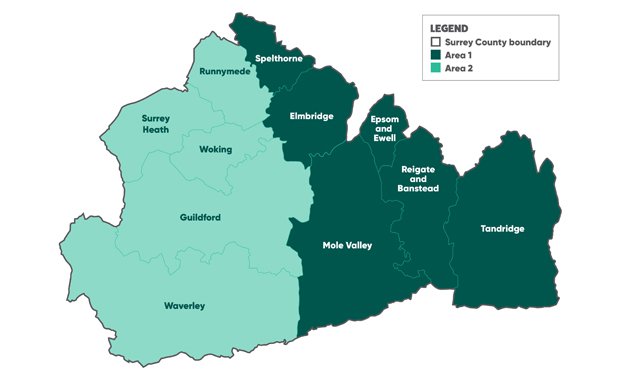
| Area | East | West |
|---|---|---|
| District and Boroughs | Elmbridge, Epsom and Ewell, Mole Valley, Reigate and Banstead, Spelthorne, Tandridge | Guildford, Runnymede, Surrey Heath, Waverley, Woking |
| Population | 648,754 | 554.353 |
| Proposed number of councillors | 86 | 76 |
Key metrics (area split as percentage)
| Area | East | West |
|---|---|---|
| Adult social care users being supported | 11,778 (52%) | 10,928 (48%) |
| Children in need | 2,644 (55%) | 2,128 (45%) |
| Children with Education Health and Care Plans | 8,791 (55%) | 7,215 (45%) |
| Pupils in school | 87,616 (54%) | 73,804 (46%) |
| Eligible for home to school travel assistance | 4,038 (49%) | 4,192 (51%) |
| Road miles | 1,530 (51%) | 1,491 (49%) |
| Anticipated council tax income | £605.32 million (55%) | £492.57 million (45%) |
| Gross value added | £26.8 billion (52%) | £24.5 billion (48%) |
Option 2.3: North/South
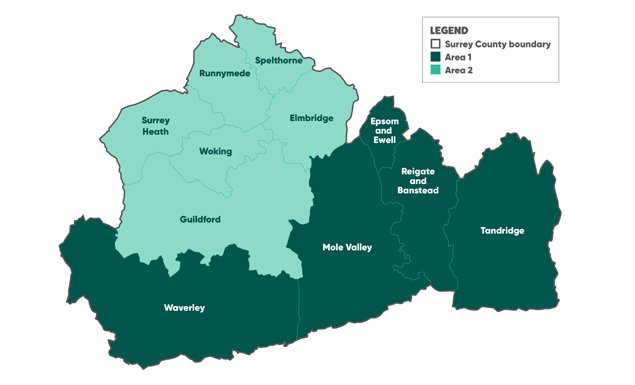
| Area | North | South |
|---|---|---|
| District and Boroughs | Elmbridge, Guildford, Runnymede, Spelthorne, Surrey Heath, Woking | Epsom and Ewell, Mole Valley, Reigate and Banstead, Tandridge, Waverley |
| Population | 667,834 | 535,273 |
| Proposed number of councillors | 90 | 72 |
Key metrics (area split as percentage)
| Area | North | South |
|---|---|---|
| Adult social care users being supported | 12,383 (55%) | 10,323 (45%) |
| Children in need | 2,854 (60%) | 1,918 (40%) |
| Children with Education Health and Care Plans | 8,790 (55%) | 7,216 (45%) |
| Pupils in school | 87,971 (54%) | 73,449 (46%) |
| Eligible for home to school travel assistance | 4,211 (51%) | 4,019 (49%) |
| Road miles | 1,449 (48%) | 1,572 (52%) |
| Anticipated council tax income | £603.83 million (55%) | £494.07 million (45%) |
| Gross value added | £31.5 billion (61%) | £19.8 billion (39%) |
Option 2.4: North/South
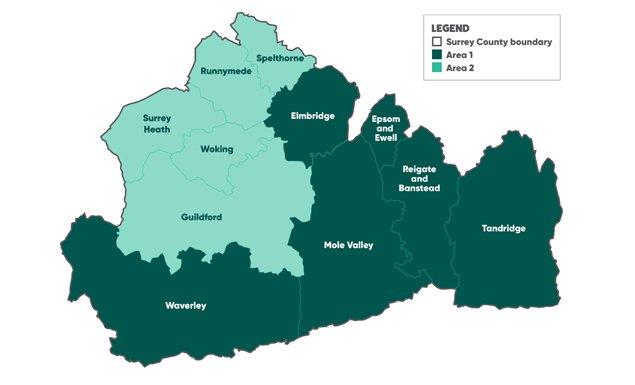
| Area | North | South |
|---|---|---|
| District and Boroughs | Guildford, Runnymede, Spelthorne, Surrey Heath, Woking | Elmbridge, Epsom and Ewell, Mole Valley, Reigate and Banstead, Tandridge, Waverley |
| Population | 529,080 | 674,027 |
| Proposed number of councillors | 72 | 90 |
Key metrics (area split as percentage)
| Area | North | South |
|---|---|---|
| Adult social care users being supported | 10,190 (45%) | 12,516 (55%) |
| Children in need | 2,296 (48%) | 2,476 (52%) |
| Children with Education Health and Care Plans | 7,087 (44%) | 8,919 (56%) |
| Pupils in school | 70,633 (44%) | 90,787 (56%) |
| Eligible for home to school travel assistance | 3,493 (42%) | 4,737 (58%) |
| Road miles | 1,200 (40%) | 1,821 (60% |
| Anticipated council tax income | £460.07 million (42%) | £637.82 million (58%) |
| Gross value added | £24.7 billion (48%) | £26.6 billion (52%) |
Three unitary authorities
This would lead to the creation of three unitary authorities, each with populations exceeding 370,000. Their boundaries would be coterminous with the current county boundaries. An example of the three unitary model is shown below.
We are not proposing to pursue three unitary authorities because:
- The additional complexity and costs of disaggregating into three unitary authorities compared to two.
- Potential impact to Surrey's economy with greater risks to less prosperous areas unable to benefit from wider investment and have smaller council tax bases to draw on.
- They would not meet the government's population criteria of 500,000 or more for new unitary authorities.
- Three unitary authorities would lead to greater costs for Surrey residents over the long term and less financially sustainable local authorities. It would also be the most expensive option to implement.
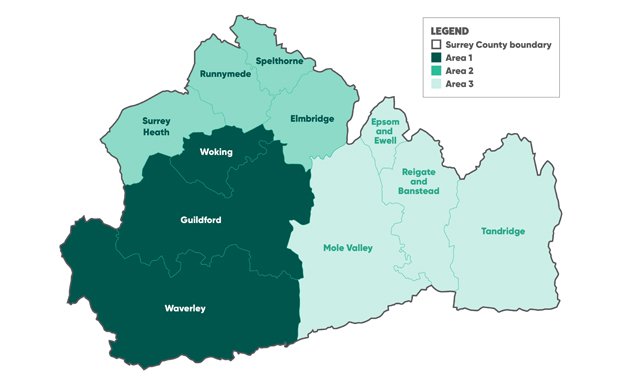
| Area | West | North | East |
|---|---|---|---|
| District and Boroughs | Guildford, Waverley, Woking | Elmbridge, Runnymede, Spelthorne, Surrey Heath | Epsom and Ewell, Mole Valley, Reigate and Banstead, Tandridge |
| Population | 375,821 | 420,242 | 407,044 |
| Proposed number of councillors | 52 | 56 | 54 |
The table below shows how the area would split across key financial and socio-economic indicators, using a snapshot of the latest available data for each indicator:
| Area | West | North | East |
|---|---|---|---|
| Adult social care users being supported | 7,170 (32%) | 8,009 (35%) | 7,527 (33%) |
| Children in need | 1,384 (29%) | 1,861 (39%) | 1,527 (32%) |
| Children with Education Health and Care Plans | 5,006 (31%) | 5,489 (34%) | 5,511 (34%) |
| Pupils in school | 50,009 (31%) | 55,914 (35%) | 55,497 (34%) |
| Eligible for home to school travel assistance | 2,843 (35%) | 2,560 (31%) | 2,827 (34%) |
| Road miles | 1,082 (35%) | 833 (28%) | 1,106 (36%) |
| Anticipated council tax income | £339.2 million (31%) | £384.2 million (35%) | £374.5 million (34%) |
| Gross value added | £13.3 billion (26%) | £22 billion (43%) | £16 billion (31%) |
We set out advantages and disadvantages of three unitary authorities below:
Advantages
- Devolution – a new Strategic Authority for Surrey could be established which would be coterminous with the current county boundaries.
- Services would be simplified and improved compared to arrangements under the current 12 councils in Surrey.
- Services that are fragmented could be combined to create scale, such as waste collection and disposal services.
- The new authorities would be able to direct and tailor use of resources to the specific needs of the communities living in each authority's area.
- Greater depth of understanding of economic challenges and opportunities in each unitary area compared to a single and two unitary authorities.
- There would be enhanced financial sustainability with three unitary authorities compared to the current system of 12 councils.
Disadvantages
- Establishing three new councils would create multiple touchpoints for some services currently accessed by a single front door, adding complexity to the system and potential for inconsistency of outcomes, though this complexity would be less compared to the 12 councils currently operating.
- Disaggregation of county-wide services have an even greater impact on the cost and quality of those services than splitting into two unitary authorities, such as creating a need for three Directors of Adult and Children's Social Care and management teams for both areas. It would also further decrease financial benefits that could be realised compared to one or two unitaries.
- There is a risk of disparity in service provision due to more uneven distribution of staff with the right knowledge, skills and experience compared to two unitary authorities.
- Greater risk than in a two unitary scenario that a more economically prosperous authority, or authorities, reinvests proceeds of growth, e.g. business rates, within its own area, leaving the less prosperous authority, or authorities, behind.
- Less scale to provide support and resources to convene and deliver local improvements in partnership with communities.
- Greater risk of uneven economic asset split, such as employment centres and innovation clusters compared to two unitary authorities.
- Split of council income across the county will mean fewer resources from local government to invest in supporting growth in the East of Surrey, which has historically underperformed compared to the West and needs further investment. Research from University of Surrey - Charting Surrey's Post-Covid Rescue, Recovery and Growth
- Net costs will significantly outweigh any benefits from reorganisation and transformation, adding to the new councils' financial pressures from day one. This model is unlikely to lead to financial efficiencies.
- Given the level of existing debt across Surrey's 12 councils, there is a risk that at least one of the new authorities would need Exceptional Financial Support from inheriting this debt if an alternative solution was not found.
- Population – the population sizes in each authority would be below 500,000. This does not meet the government's population criteria. In addition, there could be operational resilience challenges.
Financial appraisal
An initial financial appraisal has been undertaken of creating unitary councils to enable the unlocking of further devolution via a Surrey-wide Strategic Authority. Benefits and costs have been calculated based on published 2025/26 planned expenditure across Surrey's current authorities. Where information from previous years has been used for certain areas of the modelling, this has been inflated to 2025/26 to ensure a consistency across all data points for the modelling assumptions to be applied to.
The following have been appraised:
- Reorganisation benefits – savings assessed as achievable in the short-term from consolidating leadership and senior management across the 12 councils, initial wider workforce savings and non-staffing expenditure savings due to consolidation, and savings from reducing the number of councillors and local elections in Surrey.
- Transformation benefits – savings that will take longer to realise, as they are more reliant on changes to be delivered after the new unitary authorities are established. These include wider workforce and reduction in non-staffing expenditure savings beyond the lower level of initial savings achieved through reorganisation alone, reduction in property revenue costs through consolidating Surrey's existing local authority operational estate, reduction in debt servicing costs and a modest increase proposed for sales, fees & charges income.
- Disaggregation costs – these apply to scenarios where two or three new unitary authorities are established. They represent the estimated additional cost of splitting services across the new unitary geographies that are currently provided or commissioned by Surrey County Council on a county footprint. It is assumed that additional management costs below leadership and senior management level (already captured in full in the net reorganisation benefits) will be required, as well as additional costs for some specialist roles that will be needed in each authority. While costs will be minimised wherever possible, splitting county services over different geographies will also have a degree of additional cost impact for current County Council non-staffing service delivery expenditure.
- Implementation costs – these represent the estimated costs to both enable the effective creation of the new unitary arrangements and delivery of the changes required to achieve the transformation benefits once the new authorities have been set up. These costs are summarised in the Implementation section of this interim plan.
All the above have been modelled to assess the scale of benefits achievable and costs resulting from creating unitary local authorities in Surrey. The following scenarios have been considered for each unitary option:
- Base scenario – these are more conservative estimates of potential savings, and a higher level of implementation costs estimated as being required.
- Stretch scenario – these represent more ambitious scenarios with a higher level of achievable potential savings but come with a higher level of risk, together with a lower level of implementation costs being required based on taking action to limit costs where possible.
- Mid-point – these represent the mid-point between the base and stretch scenarios and are considered a reasonable estimate balancing prudence and ambition.
Modelling for each unitary option is set out in the tables below. We have modelled a single unitary as a benchmark. These show the estimated ongoing annual net benefits or costs five years after the creation of the new authorities when it is anticipated a new steady state should be reached. Positive figures in black represent benefits, while negative figures in red represent costs.
A summary of the cumulative net cash flows for each option and scenario is provided, covering the base year (2025/26) up to five years post-implementation (2031/32). The payback period is an estimate of the number of years required for total cumulative benefits to surpass cumulative costs. Where this is displayed as "N/A" this means an option has been modelled as not paying back by the end of the fifth year following Vesting Day of the new authorities.
1 Unitary summary modelling (for benchmarking)
| Financial model | Base scenario | Stretch scenario | Mid-point |
|---|---|---|---|
| Annual reorganisation benefits | £26m | £31m | £28m |
| Annual transformation benefits | £48m | £75m | £62m |
| Total ongoing annual net benefits / (costs) after five years | £74m | £106m | £90m |
| Total implementation costs | -£75m | -£63m | -£69m |
| Cumulative net cash benefits / (costs) after five years of new organisation(s) including implementation costs | £212m | £334m | £273m |
| Payback period within five years post go live | 1.5 years | 1.1 years | 1.3 years |
2 Unitaries summary modelling
| Financial model | Base scenario | Stretch scenario | Mid-point |
|---|---|---|---|
| Annual reorganisation benefits | £16m | £21m | £19m |
| Annual transformation benefits | £35m | £54m | £44m |
| Annual disaggregation costs | -£43m | -£29m | -£36m |
| Total ongoing annual net benefits / (costs) after five years | £8m | £47m | £27m |
| Total implementation costs | -£85m | -£66m | -£75m |
| Cumulative net cash benefits / (costs) after five years of new organisation(s) including implementation costs | -£74m | £92m | £9m |
| Payback period within five years post go live | N/A | 2.7 years | 4.7 years |
3 Unitaries summary modelling
| Financial model | Base scenario | Stretch scenario | Mid-point |
|---|---|---|---|
| Annual reorganisation benefits | £8m | £13m | £10m |
| Annual transformation benefits | £27m | £43m | £35m |
| Annual disaggregation costs | -£43m | -£29m | -£36m |
| Total ongoing annual net benefits / (costs) after five years | -£29m | £13m | -£8m |
| Total implementation costs | -£91m | -£68m | -£79m |
| Cumulative net cash benefits / (costs) after five years of new organisation(s) including implementation costs | -£240m | -£51m | -£146m |
| Payback period within five years post go live | N/A | N/A | N/A |
Two unitaries are estimated to deliver ongoing net annual benefits of between £8 million to £47 million and a cumulative net cash position after five years ranging from a net additional cost £74 million in the base scenario to a net benefit of £92 million in the stretch scenario.
The three unitaries option is the least favourable financially with modelling estimating an ongoing annual net additional cost of £29 million in the base scenario up to an ongoing annual net benefit of £13 million in the stretch scenario. Due to the lower savings and higher costs estimated for the creation of three unitaries, the base and stretch scenarios both estimate a significant cumulative net additional cost by the end of five years after creation of the new authorities, ranging from £51 million to £240 million.
The mid-point position for each option is summarised in table below to demonstrate the scale of difference between the three options:
| Financial model | 1 unitary | 2 unitaries | 3 unitaries |
|---|---|---|---|
| Annual reorganisation benefits | £28m | £19m | £10m |
| Annual transformation benefits | £62m | £44m | £35m |
| Annual disaggregation costs | N/A | -£36m | -£53m |
| Total ongoing annual net benefits / (costs) after five years | £90m | £27m | -£8m |
| Total implementation costs | -£69m | -£75m | -£79m |
| Cumulative net cash benefits / (costs) after five years of new organisation(s) including implementation costs | £273m | £9m | -£146m |
| Payback period within five years post go live | 1.3 years | 4.7 years | N/A |
In addition to considering the annual ongoing net impact of the creation of the new unitary authorities, we have assessed how quickly benefits will be delivered and costs incurred. The table above summarises the modelled cumulative net cash position up to five years following the launch of the new authorities for the mid-point of each option.
There are two main reasons for the difference between the different unitary options. Firstly, the scale of benefits and secondly, transformation benefits will take longer to realise than reorganisation benefits and costs for implementation and disaggregation. Therefore, the models for multiple unitaries show a reduced cumulative cash flow and lower net savings.
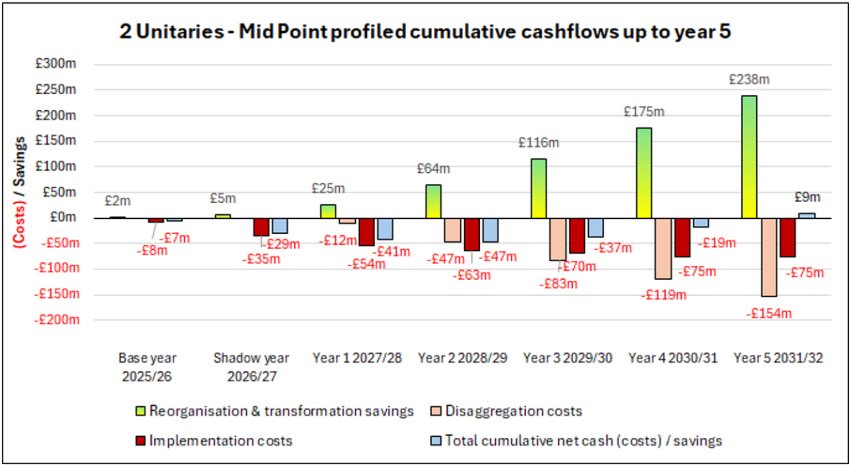
This chart shows modelled cashflows relating to Local Government Reform (LGR) over a seven-year period from 2025/26, the base year for LGR planning in Surrey, through to 2031/32, five years after vesting day of the new unitaries, for the scenario where two new unitary authorities are created in Surrey. The chart shows that over the seven-year period there are estimated to be total cumulative reorganisation and transformation benefits of £238m, offset by total additional costs of £154m relating to disaggregating services currently provided by the County Council and total implementation costs of £75m resulting in a total cumulative net cashflow position over the seven-year period of a saving of £9m.
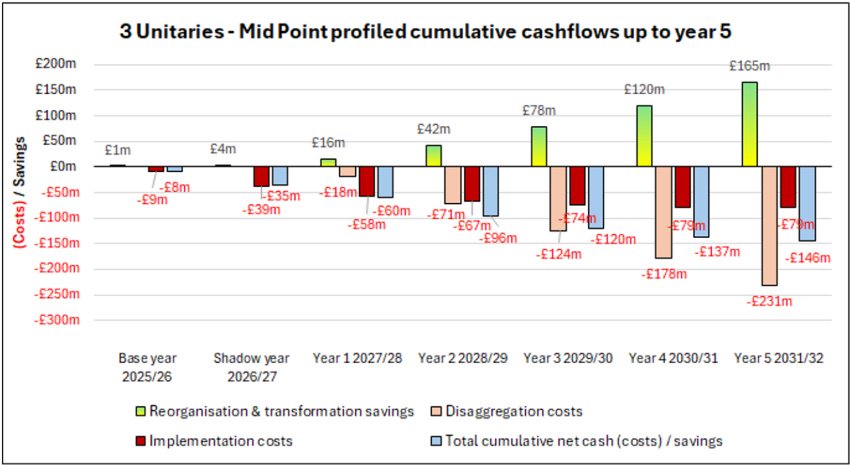
This chart shows modelled cashflows relating to Local Government Reform (LGR) over a seven-year period from 2025/26, the base year for LGR planning in Surrey, through to 2031/32, five years after vesting day of the new unitaries, for the scenario where three new unitary authorities are created in Surrey. The chart shows that over the seven-year period there are estimated to be total cumulative reorganisation and transformation benefits of £165m, offset by total additional costs of £231m relating to disaggregating services currently provided by the County Council and total implementation costs of £79m resulting in a total cumulative net cashflow position over the seven-year period of an additional cost of £146m.
It is important to note that the financial appraisal at this stage is based solely on the implications of creating one, two or three authorities and does not consider the direct financial implications of the creation of a Mayoral Strategic Authority. This will be reviewed when greater clarity is provided by government about the benefits and costs associated with the creation of a Mayoral Strategic Authority for Surrey.
In summary:
- Two unitaries are estimated to deliver ongoing net annual benefits of between £8 million to £47 million and a cumulative net cash position after five years ranging from a net additional cost £74 million in the base scenario to a net benefit of £92 million in the stretch scenario.
- In creating two unitaries we will need to minimise disaggregation costs as far as possible and seek to get as close to the delivery of the stretch benefits.
- It is anticipated that Surrey will face funding reductions when the local government funding system is reformed. This makes it even more important to ensure LGR delivers savings to mitigate pressures and help reduce the current medium-term gap identified across the existing local authorities in Surrey.
Work will continue to refine the financial appraisal of the different options, including close collaboration across Surrey's 12 councils. An updated assessment will be included in the final proposal.
Options appraisal conclusion
In conclusion, reorganising to two new unitary authorities is our preferred option for local government in Surrey. Two unitary authorities would support a key objective to unlock further devolution for Surrey by supporting establishment of a new Strategic Authority on the current county footprint. It is also the only option that will achieve this while also meeting the government's criteria that new unitary councils are financially sustainable.
Two unitary authorities would also be more efficient and provide greater scale compared to the status quo of 12 councils and a three unitary option. Two unitaries would balance local knowledge and understanding of the residents they serve so they can prioritise resources more effectively, enabling better outcomes.
If, following government's consultation on LGR options for Surrey, they are minded to accept our proposition for two new unitary authorities, careful planning will be required to mitigate risks and disruption from the disaggregation of county-wide services, particularly considering the needs of vulnerable residents that depend on them. We cover this in more detail in the implementation section.

Democracy and governance
Strengthening local democracy
Under our proposals for LGR, local democracy for Surrey will be strengthened, giving residents more clarity on who their local councillors are and supporting Members in their roles to effectively champion the needs of their places. They will be a dedicated link between the new councils and residents and businesses in their divisions, as well as enabling strengthened relationships with other public service providers, such as town and parish councils.
We propose retaining the county council electoral divisions in the new unitary arrangements, as these were agreed as part of the 2024 Local Government Boundary Commission for England (LGBCE) Boundary Review for Surrey, and were due to be implemented for the May 2025 County Elections. This review is the most recent that has been undertaken across all Surrey councils and is therefore based on recent electorate data.
To ensure we can progress LGR at pace, we are also not proposing arrangements that would require a boundary review or that any of the county or district and borough boundaries are split or changed.
At present, there are 81 county councillors and 464 district and borough councillors across Surrey. To enable strengthened democratic representation for the new unitary councils, we propose two councillors per division. Countywide, this would lead to, on average, 5,542 electors per councillor based on current 2025 data from the electoral roll, and an average of 5,956 electors per councillor, based on 2029 projections. Proposed councillor numbers were included against each option in the options appraisal and were based on councillor-electorate ratios of around 1:5,500, which is in line with other unitary authorities.
To ensure effective scrutiny and facilitate more stable and strategic leadership, we also propose adopting a model of whole council elections every four years, like those used by Epsom and Ewell, Guildford, Spelthorne, Surrey Heath, and Waverley borough councils as well as Surrey County Council. This is preferred over the current system in some districts and boroughs where elections are held in thirds. Whole council elections will create clearer accountability for residents, lowering costs by reducing frequency of elections and reducing voter fatigue with the aim of seeing increased voter participation at each election.
Empowering Surrey's towns and villages
The governance models for the two new unitaries will complement the work we are already doing to strengthen participation and engagement across our towns and villages. We know people value being able to influence the decisions that impact them and their local area. LGR can create concerns that community governance, participation and voice may be reduced. We won't let this happen.
In line with the government's criteria, we are committed to using LGR to establish even stronger arrangements for local community engagement and neighbourhood empowerment, using a wide range of inclusive approaches that build on current good practices across the county. Crucially, Surrey is blessed with a rich civic life, including community groups and forums, residents' associations, voluntary, community, social enterprise and faith organisations, town and parish councils, business forums and many more. The two new unitary authorities will ensure effective collaborative arrangements with these vital community-based groups and associations.
LGR will enable us to further develop stronger models of joint partnership working at local levels. Surrey's geography, reflecting its history, is one of multiple towns and villages rather than single centres. These towns and villages are typically the "real places" that people identify with, over and above any administrative boundaries. They are also the key building blocks at which practical outcomes can be delivered for residents at a local level.
In recent years, all Surrey's councils have worked ever closer alongside communities and other organisations at these meaningful local scales – and crucially local NHS partners have aligned into this model to develop integrated neighbourhood teams, better joining up care and support. The government's forthcoming 10-Year Health Plan for the NHS is expected to further emphasise a local neighbourhood focal point and will continue to encourage whole-person health and wellbeing, not just medical interventions. We have made positive progress on this front already in Surrey with nationally recognised examples of good practice.
Two unitary councils will work with partners and residents to deepen collaboration across Surrey's towns and villages so public services are locally responsive, more aligned in how they work and are effective in prioritising and delivering the outcomes that matter most to people, such as economic growth or reducing health inequalities. This will include alternative delivery models that further incentivise collaboration and formalise these arrangements as part of a wider framework for community governance in Surrey.
We will develop this further through the implementation stage, drawing on national examples, learning from work in Surrey to date, and insights from local councillors. We will review and consider a range of options to strengthen local engagement and democratic decision-making, including, but not limited to, the following:
- Town and Parish Councils
- Local Committees (comprising all unitary councillors representing communities within previous district and borough boundaries or smaller areas as appropriate)
- Community Area Partnerships
Any structures involving local elected representatives associated with the current Surrey County Council Delivering in Partnership Strategy (the Towns and Villages approach).
Thanks to the commitment and efforts of all partners in Surrey we do have a strong platform to build from and LGR will unlock even smarter use of collective resources and collaboration with residents to improve the places they live, support civic pride, and achieve better quality of life.
Horley, in Reigate and Banstead, was identified as a priority town for community-led improvements and socio-economic development in 2021/22 given the impact of Covid-19 on nearby Gatwick Airport which is central to the local economy and jobs. Surrey County Council (SCC), Reigate and Banstead Borough Council (RBBC) and East Surrey NHS committed to a joint focus on the town. RBBC's longstanding commitment to community development and the local NHS's focus on community-led health creation meant there was a strong base for establishing even better connections with the local community. With dedicated additional expertise and resource from SCC's economy and growth team, a wide range of local groups were convened, including the VCSE, Town Council, businesses and local schools among others.
Local conversations, including with young people, helped shape a clear shared vision for the town. This helped to coordinate a range of strategic investments into practical projects across the partnership that are: improving the public realm; creating a town centre offer for young people; opening up a new commercial space; providing better active travel options; and supporting more community-based support for health and wellbeing.
Case example: Horley community-led improvements
In summary, our proposed democracy and governance models will:
- Provide an appropriate level of capacity for councillors to lead effective, accountable local services and represent their communities successfully.
- Create a clear point of contact for residents.
- Streamline councillor support services across the county and reduce the number of elections, ensuring this funding can be directed towards improving services for our residents.
- Strengthen local democracy, and make it more inclusive, by integrating councillor representation into our local partnership arrangements.
In the next section, we set out our high-level approach to implementing our proposals, including the phasing, implementation costings and broad approach we will take to disaggregation and service integration.

Implementation
Phasing
We plan to take a phased approach to creating and implement the new unitary councils.
Our emerging implementation plan will consist of six main phases, some of which will run concurrently:
- Business case development and mobilisation
- Government consultation
- Preparing for implementation
- Elections and establishment of Shadow Authorities
- Vesting Day, transformation and benefits realisation
Mayoral Strategic Authority establishment
Phase 1 (January to May 2025)
Building the case
- Options appraisal
- Interim and final LGR plan
- Early preparations for implementation planning
Status: Current
Phase 2 (June to autumn 2025)
Government Consultation
- MHCLG reviews business case(s), carries out statutory consultation and decides preferred option
- Implementation preparation continues
Status: Not yet begun
Phase 3 (autumn 2025 to April 2026)
Preparing for implementation
- LGR implementation plan developed
- Design of new authorities
- Election preparations
- Devolution implementation plan developed
Status: Not yet begun
Phase 4 (May 2026 onwards)
Shadow Authorities
- Elections to new local government authorities
- Shadow governance arrangements established
- Preparation for Vesting Day
- Note during this period existing councils will continue to have responsibilities for service deliver
Status: Not yet begun
Phase 5 (Vesting Day. April 2027 onwards)
Transformation and benefits realisation
- Transformation and improvement programmes support benefits realisation
Status: Not yet begun
Phase 6 (To be confirmed: 2027 or 2028)
Mayoral Strategic Authority
- Government devolve powers and funding to Mayor
Status: Not yet begun
The timing of the phases above is subject to change. Each phase will require specific skills and resources. The capacity required will depend on how many unitary councils are created, with implementation costs increasing for each additional council.
Implementation and programme team costs
We propose one programme to oversee and deliver the changes. This will ensure the most efficient use of resources and keep costs to a minimum. The primary approach will be to identify work that can be paused or stopped within all existing councils to repurpose roles that are already in the establishment, but it is recognised that additional capacity may be required at certain points during the programme. Costings are based on internal delivery, but the future authorities may decide to invest in external support.
It is expected that investment and resourcing for implementation will be a collaborative approach between all Surrey councils, with a multi-disciplinary change team being set up with representatives from all 12 councils.
A summary of estimated implementation costs is set out in the table below. Our modelling covers all potential costs (such as branding, creating the new councils, closing down old councils and IT) along with a programme delivery team. These estimated costs cover early planning through to delivery of planned transformation benefits.
1 unitary
| Cost category | Base | Stretch |
|---|---|---|
| Redundancy and early retirement | -£17.6m | -£23.4m |
| Implementation and programme delivery team | -£20.5m | -£15.4m |
| IT consolidation and change | -£22.1m | -£13.0m |
| Branding and communications | -£2.0m | -£1.5m |
| Shadow authority (ies) | -£0.7m | -£0.7m |
| Creation of new council(s) | -£1.0m | -£1.0m |
| Closedown of old councils | -£1.4m | -£1.1m |
| Contingency | -£9.5m | -£6.5m |
| Total implementation costs | -£74.6m | -£62.5m |
2 unitaries
| Cost category | Base | Stretch |
|---|---|---|
| Redundancy and early retirement | -£11.0m | -£15.6m |
| Implementation and programme delivery team | -£26.1m | -£19.6m |
| IT consolidation and change | -£28.7m | -£16.9m |
| Branding and communications | -£2.0m | -£1.5m |
| Shadow authority (ies) | -£1.3m | -£1.3m |
| Creation of new council(s) | -£2.0m | -£1.5m |
| Closedown of old councils | -£1.4m | -£1.1m |
| Contingency | -£12.3m | -£8.4m |
| Total implementation costs | -£84.8m | -£65.9m |
3 unitaries
| Cost category | Base | Stretch |
|---|---|---|
| Redundancy and early retirement | -£5.7m | -£9.4m |
| Implementation and programme delivery team | -£30.6m | -£23.0m |
| IT consolidation and change | -£32.0m | -£18.9m |
| Branding and communications | -£2.0m | -£1.5m |
| Shadow authority (ies) | -£2.0m | -£2.0m |
| Creation of new council(s) | -£3.0m | -£2.3m |
| Closedown of old councils | -£1.4m | -£1.1m |
| Contingency | -£14.2m | -£9.7m |
| Total implementation costs | -£90.8m | -£67.7m |
Mid-point Base and Stretch
| Cost category | 1 unitary | 2 unitaries | 3 unitaries |
|---|---|---|---|
| Redundancy and early retirement | -£20.5m | -£13.3m | -£7.5m |
| Implementation and programme delivery team | -£17.9m | -£22.8m | -£26.8m |
| IT consolidation and change | -£17.6m | -£22.8m | -£25.4m |
| Branding and communications | -£1.7m | -£1.7m | -£1.7m |
| Shadow authority (ies) | -£0.7m | -£1.3m | -£2.0 |
| Creation of new council(s) | -£1.0m | -£1.8m | -£2.6m |
| Closedown of old councils | -£1.2m | -£1.2m | -£1.2m |
| Contingency | -£8.0m | -£10.3m | -£12.0m |
| Total implementation costs | -£68.6m | -£75.3m | -£79.3m |
Costings for the base scenarios represent the higher end of estimates on a more prudent basis and costings for the stretch scenarios represent the extent it is considered it may be possible to contain costs. The contingency is set at 20% of all costs excluding redundancy and early retirement, which is costed based on the average cost of redundancies for Surrey County Council and directly linked to the level of modelled workforce savings for each option. At this point, implementation costs for a Mayoral Strategic Authority have not been included.
Initial estimated costs are highest for three unitaries primarily due to the need for additional implementation and programme delivery team resource and higher anticipated costs for IT consolidation and change costs, for instance to establish three sets of new systems for many service areas.
Aggregation, disaggregation, and integration
Creating multiple unitary councils will require the disaggregation of county services to split between the new unitaries. This will include designing new leadership structures within those service areas along with wider team structures and operating models. This brings with it significant risks, especially in areas such as social care services where there cannot be any disruption or degradation of service quality.
Regardless of the number of unitary councils, district and borough services will need to be aggregated to realise economies of scale. This includes consolidating management positions, systems, and teams to provide a more efficient and cost-effective model.
Where there are common services across county, district and borough councils, there is an opportunity to integrate these services to create high quality and more cost-effective models. Some of the services that could be in scope are IT, HR, Procurement, Legal, Democratic Services & Internal Audit. We will consider this further in the final plan.
Transformation
Where possible we will seek to transform services through the implementation process, but it is highly likely that the majority of transformation will take place from day two onwards, so we can ensure a safe and legal position on Vesting Day.
Moving to unitary local government in Surrey provides significant opportunities to improve the quality, cost, and consistency of service delivery across the county. The approach set out in this interim plan will continue to be developed and refined, taking the learning from other councils that have already been through the process of LGR.
Supporting a swift and smooth transition
For the transition to unitary local government to proceed as smoothly as possible, we wish to explore with government the appointment of a lead authority in regards to transitional processes and arrangements.
There is precedent under section 24 of the Local Government and Public Involvement in Health Act 2007 where a body with general transitional duties should have a say on agreements entered into, to ensure those are in the best interests of residents in the area, and do not undermine or diminish the benefits and savings or have a material impact on the financial position of the new council.
Engagement
Working with stakeholder, partners and residents
A range of partners in Surrey from local government and the wider public sector have been engaged in the development of this interim plan and will continue to be engaged as we develop our final LGR proposals and subsequent implementation.
We have engaged commissioners for Woking Borough Council in the discussions and analysis of LGR options for the county, ensuring the financial complexities are taken into account.
All of Surrey's Members of Parliament have been engaged through existing touch points with members and regular one-to-one meetings between the Leader of the County Council and local MPs.
The primary mechanism for engagement with wider public sector partners has been through the Combined Health and Wellbeing and Integrated Care Partnership Board meetings which involve partners from Surrey Heartlands Integrated Care System (ICS), Frimley ICS, Surrey Police, Surrey Fire and Rescue, District and Boroughs and representatives from the Voluntary, Community and Social Enterprise sector. The group has been regularly updated on the development of the interim plan for LGR in Surrey.
Furthermore, an initial briefing was arranged in February to brief partners from Further Education, Higher Education, Surrey Businesses, the NHS, Police and Crime Commissioner, Surrey Police, the Voluntary Sector, and Surrey Fire and Rescue. At this meeting partners discussed the importance of community engagement, health and wellbeing, and skills in the new arrangements, and how LGR and devolution can strengthen our already strong working relationships.
There are active conversations with the Chief Constable and Police and Crime Commissioner as well as with the Chairs and Chief Executives of Surrey Heartlands and Frimley ICS around reorganising their operational footprint to align with the county proposal set out above.
Existing partner engagement mechanisms such as the Surrey Forum, a county-wide, multi-agency partnership of system leaders set up by the Leader of Surrey County Council to provide aligned strong and visible leadership for Surrey, the Surrey Charities Forum, a monthly meeting bringing together representatives from the county's voluntary sector, and regular meetings with the Surrey Association for Local Councils, who represent the interests of Surrey's parish and town councils, have also been utilised to brief and engage partners in the development of the interim plan. These wide-ranging engagement mechanisms have allowed local partners to discuss and feed into the drafting of the interim plan and will shape the content of the final proposal submitted for Surrey.
To engage with, and understand the views of, Surrey residents, we are keeping them regularly updated and undertaking some initial research with a representative sample of residents via our online panel to understand what outcomes they would most like to see resulting from LGR. This is a tool we will continue to use to engage with residents throughout the process, and will complement wider, open engagement activities and events.
Surrey County Council staff are also being regularly updated and engaged with, to understand their views, answer questions and ensure they are prepared. A range of communication methods are being adopted to ensure both staff working in offices and in frontline roles are informed and engaged.
Within Surrey County Council, an LGR Member Reference Group (MRG) has been established to bring together Select Committee Chairs, Vice Chairs, other senior backbench Members including Group Leaders, the Chair and Vice-Chair of the Council and Chairs of the Regulatory Committees. The Leader of the County Council meets with them to discuss and scrutinise the analysis of LGR options being explored for inclusion in the interim and final LGR proposals. The group has met three times ahead of the interim plan deadline and will meet at least once more ahead of the 9 May deadline for the final proposal.
All county councillors were invited to an All-Member Briefing on 25 February which briefed Members on the English Devolution White Paper, the government's LGR submission criteria, and the approach to meeting the government's timetable. Members were also briefed on the approach officers had taken for the analysis and options appraisal. In a further meeting on 10 March all Members were briefed on the contents of the draft interim submission ahead of the Cabinet and Council meetings on the 18 March.
An item on Devolution and LGR was also presented to Surrey County Council's Full Council meeting on 18 March and a Cabinet meeting was held on the same day. Members of Surrey County Council and Cabinet were asked to review and discuss the drafted submission for the interim plan ahead of Cabinet agreeing to submit this plan to government.
Further planned engagement
Further engagement is planned ahead of the 9 May deadline. The MRG will hold further meetings to discuss and scrutinise content of the final proposal ahead of this being considered the Full Council and Cabinet meetings scheduled for 7 May. All County Council Members have also been invited to a further briefing on 28 April, ahead of the final proposal deadline.
MPs and wider partners will be engaged through aforementioned mechanisms including the Health and Wellbeing Board and Integrated Care Partnership Board meetings, the Surrey Forum, the Charities Forum, briefings and existing meetings with the Leader and senior officers.
The planned engagement will help us to ensure that partners, residents and staff continue to discuss their views and feed into the shaping of the final proposal submitted for Surrey.
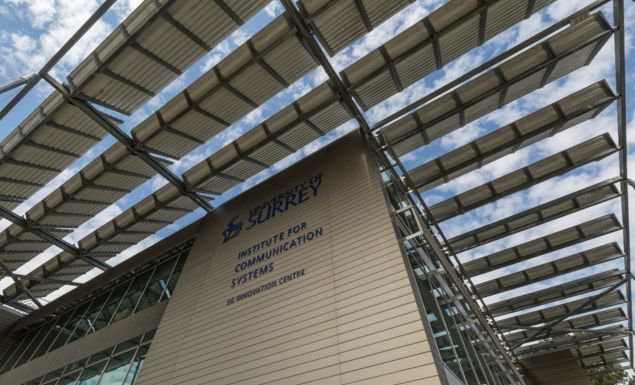
Conclusion and next steps
Our preference is for two new unitary councils as the best way forward for unlocking further devolution for Surrey in line with the government's criteria. It sets the stage for longer term public service reform in Surrey, with an aim of unifying public services to achieve the best value for money and improved outcomes for residents.
Two unitary authorities for Surrey will also strike the right balance between operating at greater scale for more efficient and financially sustainable local government while enabling scarce resources to be directed into the unique needs and priorities of the communities they serve.
As we finalise our proposals, we will continue to engage local partners and other key stakeholders to support their development. We recognise the importance of working with our partners so we can better understand the impact of LGR for them and how we can work together as Surrey transitions to a new model of local government to minimise disruption for residents and build on successful partnership working under the current two-tier system.
We will also continue to refine our analysis as we work through further risks and issues to be explored in the planning and implementation for the new authorities. Further detail will be presented in our final proposals in May.
Our final LGR proposals will be presented to Surrey County Council's full Council and Cabinet meetings on 7 May 2025. In parallel, we will continue to work with government and the district and borough councils on finding solutions to the barriers and challenges referred to earlier in this plan.
We look forward to engaging government, and other stakeholders, on this plan and helping us to shape these proposals further. We are confident that with the right support, our proposals can help deliver a new era of local government for Surrey, and unlock a new Mayoral Strategic Authority, that supports the ambitions of the county's residents and businesses to give everyone the same chances to thrive in the county, supports further economic growth and ensures that no-one is left behind.
Resources
Our Interim Proposal is available in a PDF version for you to download.
Districts' & Boroughs' Proposal
Districts' & Boroughs' Proposal for future reorganisation of Surrey.

